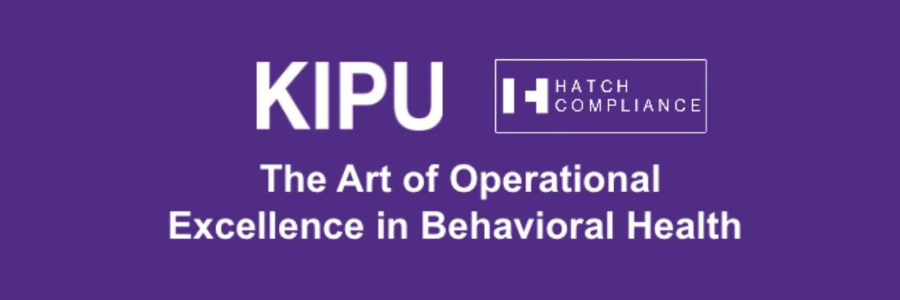The Art of Operational Excellence in Behavioral Health

Kipu Health and Hatch Compliance brought together six behavioral health experts that outlined the critical practices to stay ahead of the ever-changing Texas landscape and discussed the crucial blind spots to avoid. This interactive panel’s discussion included:
- Pivotal KPIs to track for successful growth in all functions including admissions, compliance, staffing, and revenue cycle.
- The blind spots to avoid in compliance by preparing your team for new HHS violation policies including those on Chemical Dependency Treatment facilities.
- And how to operationalize your data for a stronger transformative roadmap to high growth.
Our expert panelists ranged across different areas of the behavioral health industry including billing, compliance, and technology. Click here to view each panelists’ bio.
Your Expert Panelists

Renee Douthat, Founder and Chief Compliance Officer, Hatch Compliance
Before co-founding Hatch Compliance, Renee served as the Chief Business Development Officer for the 11th largest substance abuse treatment organization in the United States. She is responsible for mobilizing eighteen substance abuse facilities from mere concepts to profitable businesses. Renee is an expert in behavioral healthcare compliance and a revered name throughout the substance use disorder community. Her uncanny ability to standardize and simplify organizational compliance motivates her to seek new and innovative solutions to constantly evolving industry pain points.

Ben Dittman, Founder of Avea Solutions
Ben is the founder of Avea Solutions software that brings leading edge revenue cycle management solutions specifically to addiction treatment, eating disorder treatment and behavioral health facilities with the AveaOffice revenue management platform. Avea minimizes headaches and maximizes human capital, efficiency, and earnings, all in one fully integrated solution. Ben is a member of the Forbes technology council and sits on the NAATP outcomes measurement council.

Maureen Hagan, LMSW, LCDC, Hill Country Billing Partners
With over 15 years’ experience in the behavioral healthcare industry, Maureen started her career in Community Mental Health working at the Center for Healthcare services as a field Qualified Mental Health Practitioner. Maureen went on to work as a Utilization Review Specialist at a treatment center in Hunt, TX where she was trained by a leading expert in Utilization Management. She went on to develop an in-house UR and Billing team at a leading treatment facility in Georgetown, TX where she worked in a management position for 8 years obtaining In-network contracts with major insurance companies, while developing systems that increased revenue exponentially.

Scott Delmarr, President, Congress Billing
Scott is the President of the Behavioral Healthcare Industry’s first Billing Management Company. Nearing 13 years of experience within the RCM industry, Scott has been at the helm of two of the industry’s largest 3rd party billing providers. However, for the past 7 years, Scott has shifted his talents to rescuing behavioral healthcare providers’ cash flow from their 3rd party billing services and their internal billing teams. Prior to him joining the world of RCM, Scott was a forensic Accountant for a top Regional CPA firm located in South Florida. Outside of his RCM rescue missions, Scott enjoys being a husband, father to two daughters and a huge lover of all outdoor activities.

Nick Jaworski, CEO, Circle Social
Nick Jaworski is an internationally recognized executive in the field of behavioral health marketing and operational consulting with experience building organizations across four continents. As the owner of Circle Social Inc., he has helped healthcare organizations ranging in revenue from $10 million to $300 million a year perform turn-arounds and accelerate growth. He is a recipient of the prestigious Jefferson Award for his work in mental health, is an adviser to the board for The Behavioral Health Association of Providers, and is also on the board for one of the most innovative treatment programs in the country – Above and Beyond Recovery in Chicago. When he’s not online, he can be found spending time with his favorite person in the whole world, his daughter.
Blake Serpa, Base Point Academy
Blake has 5 years of Behavioral Healthcare experience with operational and management experience at both Lakeview Health and Sabino Recovery nationally recognized behavioral health providers. He is a proven healthcare leader with a passion for process improvement and organizational development to facilitate clinical excellence. Blake applies innovative and progressive thinking to the changing landscape of behavioral healthcare. Additionally, Blake has experience in mergers and acquisitions through his time at Trinity Hunt Partners and Evolve Capital. Experience includes financial modeling; partnering with physician owners; business development and marketing; and financial planning and analysis.
PANEL DISCUSSIONS
Take a look at what the panel discussed as the top priorities in the behavioral health industry. To view the entire session, download the panel discussion here.
We loved seeing you all! For more event recaps, check out our blog. Keep up-to-date with the latest behavioral health news and industry practices by subscribing to our blog here!
The Great In-Network vs Out-of-Network Myth with Billing Companies
It is widely popular for a provider to ask for lower rates from their billing company because it’s assumed the billing company’s clients are considered in-network by the payers. But that assumption is a myth.
For the billing companies, claims management for both, in- and out-of-network are equal. That’s because the labor required for the job is the same.
For both in- and out-of-network, you still need to create, submit, and call for updates on claims.
Another myth: always aim for in-network only claims. Scott Delmar of Congress Billing reminds attendees that you will restrict your referrals if you stay only in-network. Always remember, you should try to help the person, in-network or out-of-network.
How do you decide whom to go in-network with?
A key advantage of going in-network is how it can increase your enterprise value. With a higher valuation, you will be able to get loans since most of your portfolios are network payers. Where do you begin though?
Pulling data is the crucial first step. Find data that will help you determine who the five major payers in your area are and how many members those payers retain. This is key to maximize the value of your contract with as many members as possible.
In Texas, they look at the insurance companies that are most supportive of facilities having in-network contracts. They are going to pay quicker, optimize more time, and they will be more supportive of the treatment that the facility is providing. It’s important to look for payers that are supportive of treatments that you are offering, like substance abuse.
Negotiating Rates with Payers
Typically, on your first contract you will receive a standard rate based your location. Unfortunately, there is little-to-no negotiating on your initial contract because there isn’t enough data for the provider to reference. After a year has passed, sufficient data comes into the picture. The payer sees datapoints like the services you are providing, the average lengths of stay for your patients, and so on. At this point, you now have more leverage to negotiate rates to reflect the level of care you are providing.
How well are providers negotiating?
Normally, the provider looks to their billing partner for all negotiations. Though, this isn’t necessarily best practice. Billing partners prefer to work in collaboration because you can effectively speak to your facility’s advantages which will stand out in negotiations. By speaking to the success of your care through outcomes measurement, you’re granting your team the best chance for success on higher reimbursements that you deserve.
What does that negotiation discussion look like?
Usually, this discussion happens a year or two after your initial contract. In that discussion, compare key data points like lengths of stay, successful discharges, readmissions, and other statistics to other facilities in your area. For example, facilities in your area typically average 14 days of residential and you are average 10 days. Your PHP program is averages 21 days while the general area averages 15 days.
Payers review all your metrics to determine how well you are providing the services. Above all, payers want the patient treated at the least restrictive level of care. This will play into how they will decide your reimbursement rates, and the value your treatment center is providing to them and their members.
What can we do as an industry to help with inflated costs for facilities?
Data. Show that you are paying staff more and the necessary technology you use is becoming more costly.
There is typically a gap between what facilities provide and what they submit from a claim’s standpoint. You are doing a disservice if you are over-providing care and not notifying payers of that care because they use those claims to analyze your performance. Look at your clinical schedule and make sure you’re in line with the level of care payers are reviewing.
Normally, they will not cover newer tactics like yoga. Reading their manuals is recommended. The behavioral health industry is working on technology to provide more data that will benefit value-based reimbursement and ultimately elevate the level of care. .
Fines: What should you look for?
HHS is stepping up their enforcement of behavioral health violations which can be costly to a provider. There are three levels, outlined by HSS, that reflect the severity of the penalties. The lowest, Level 3, can range from $100 – $5,000 per day per violation, while the highest, Level 1, can range from $15,000 – $25,000 per day per violation. Level 1 violations can result in a possible suspension or revocation of licensure.
Some of the most commonly cited standards are people are not recording incidents properly or not tracking internal incidents. It’s important to have a relationship with your case managers and do your best to avoid being fined.
Hatch Compliance and Kipu Health will post a guide on all the most commonly cited standards soon. If you’re interested, please click here.
What strategies can be implemented to maintain business development personnel?
Hiring from outside the rehab space has proven to been beneficial. We have found the retention of people inside the rehab space is low. Be sure to find people that are passionate about what they do and about the treatment your facility is providing. These folks will be bought into your company culture and will more likely stay and grow within the organization.
Don’t forget to provide proper training and support, create connections within your facilities, and establish a culture within your company. Challenge your sales model and be educational, especially with competitive advantages, to help your business development team succeed. All these strategies will help maintain personnel. .
Staffing Shortages, Scarcity, A Competitive Recruitment Market – What to do?
It’s important to roll with the dynamics of a changing world even when it seems the most challenging. One vital initiative that can help address these challenges is s creating a strong work culture within your organization. Coach and mentor your top employees and develop career plans for them. In return, they will work harder because of the support you have provided. Always remember, the leadership and executive staff needs to be a model for the work culture.
How can I create a strong work Culture
Culture begins in orientation., Educate your employee’s on your company’s cultural values and mission statements. It’s vital to remind your staff of these values in meetings and create a safe space to have open conversations. Above all, make it fun. One example is by asking yourself and your staff, “how did you represent the work culture or enhance it this past week?”
You cannot compromise your values. Diversity will be present in other aspects of your company but not your core values. Make sure you have high-level accountability for those values.
A great way to collect feedback on your work culture is by surveying your staff. Give them anonymous opportunities to report how they feel about your organization and leadership, and do they feel safe and valued.
Keep in mind, every human wants to feel safe and valued. Start a gratitude call, Slack channel, or integrate it into your calls. Ask them what they’re grateful for and what they are looking forward to. People need to get to know each other. You need to care about your people genuinely. If they know that you care, when they have an issue they will come to you because you are making an to connect with them.
Promote from within based on skillset and personality. Be transparent with your staff. Talk about their business development and continue to check in with them. You want someone to build a career with you and feel safe with you.
3 Killers Metrics to a Sustainable Business
- Your average length of stay. How long are people staying in the program? Are they stepping down appropriately? That’s your clinical team.
- Your Average daily reimbursement. Track your patient outcomes if you want a higher reimbursement. Get to know what payers value and have that data to support your facility. That is your billing and clinical team.
- Cost for admission/marketing spend. That is your marketing, vendor, business development, and admissions team.
What do payers care about:
- ER costs/ visits
- Readmission rates
- Compliance
- Medication compliance
- Connection to employment
- Connection to PCP
How do you define a successful business? (KPIs/KSIs)
- Units – How many did you render and how many got paid in a certain period?
- Reimbursement – the average of reimbursements and how many claims are re-priceable/getting re-priced. What is the average amount of increase you are getting?
- Timeframe – how long is it taking for your team to create the claim and submit the claim? When you have software like Kipu and Avea, you are cutting your day-to-day tasks in half because it is automatic.
- Outcomes – average lengths of stays, discharges, etc., and notice the trends.
- Total Annual Evaluations of Leadership – how are we as leaders doing to improve our staff?
- Finances – making sure you are knowledgeable on how your facility is doing financially
- UR: Authorized days vs Days that are billed – organize data by the case manager, payer, and level of care and see how many days are being authorized on average. That information is important to share within the organization.
We dream of a day to have a community to compare our KPI/KSIs. It can be frustrating because we all crave community, but the competitive nature keeps providers from working together to better the behavioral health industry. We need to normalize this sharing of data and use new technology to develop more accurate benchmarks.
Future Networking Events
If you’re interested in attending a future Kipu networking event, please register here. We’ll keep you up to date on the upcoming events!
Rely on Kipu to keep you ahead of change.
Subscribe to Kipu for behavioral health news, updates, community celebration, and product announcements.





